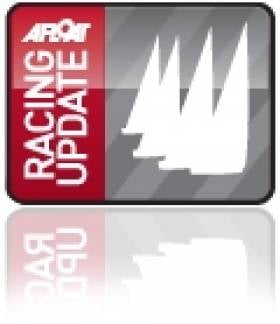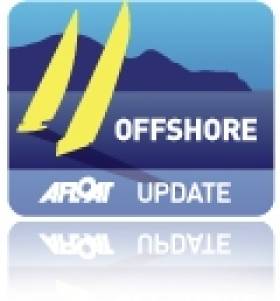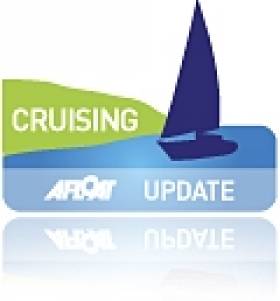Displaying items by tag: Round
Round Ireland Yacht Race 2012 Takes Shape
#SAILING–Wicklow Sailing Club's Round Ireland Yacht Race departs from Wicklow Bay at 12 noon on Sunday 24th June 2012, leaving Ireland and all its islands to starboard.
2012 mark's the 32nd anniversary of Ireland's premier off-shore sailing event, organised by Wicklow Sailing Club in association with Royal Ocean Racing Club (RORC).
It is the longest race in the Royal Ocean Racing Club calendar, comparable to similar Offshore races such as the Fastnet, Malta Middle Sea, Sydney-Hobart and China Sea races.
The first race took place in 1980 with only thirteen boats. Since then, held biennially, the fleet has grown steadily, and up to 60 yachts have competed in some past editions of the race.
The backbone for the 2008 race was Tonnerre de Breskens III, owned by Dutchman Piet Vroon. The crew arrived in Wicklow with a brace of RORC victories, leading RORC's offshore table, and went into the race as favourites. The first twist in Tonnerre's plot came before the starter's gun, when Vroon ended up in hospital, from where he would follow the race as his crew sailed on without him.
However, that would be the only bump in their road. Tonnerre led from start to finish, both on the water and on handicap. Vroon's crew brought home the trophy for their ailing skipper in the race's happy ending.
Sailing around Ireland poses many challenges for boats and crew, with open ocean on the south and west coasts, tidal challenges on north and east coasts apart from all the off lying rocks and sandbanks to keep navigators on their toes and not forgetting the vagaries of the Atlantic weather systems.
This is very much a sailors race but armchair spectators can follow the race on their computers, thanks to our modern race tracker technology.
A Round Ireland Sail Fest (Thur 21 - Sun 24 June) will complement the race preparations and add a welcome level of fun and entertainment for all coming down to Wicklow for the Race start.
ROUND IRELAND YACHT RACE 2012 on SUNDAY 24TH JUNE
NOTICE OF RACE
ORGANISATION
The Race is organised by Wicklow Sailing Club in association with the Royal Ocean Racing Club.
CONDITIONS The race will be sailed under the Racing Rules of Sailing 2009-2012, the ISAF Offshore Special Regulations, the Irish Sailing Association (ISA) and RORC Prescriptions and amendments and the additions detailed below:
1. This Notice of Race, the Entry Form and the Sailing Instructions.
2. The Race is ISAF Offshore Special Regulations Category 2.
3. IRC Rules Parts A, B, & C – 2012 Rules.
In the event of conflict the Sailing Instructions shall prevail.
START The start will be at Wicklow on Sunday, 24th June 2012.
COURSE Leave Ireland and all its islands excluding Rockall to starboard. The distance is approximately 704 nm.
ENTRIES To: Wicklow Sailing Club, C/o. Dennis Noonan, "Dunmore", Sea Road, Newcastle, Co. Wicklow. The closing date for entries is 8th June 2012. Exceptionally late entries may be accepted, for which there will be a late entry fee. Entries will be from IRC (Endorsed) rated yachts of LOA 9.15m/30 feet and over, with a minimum SSS of 28 or STIX of 32 combined with an AVS minimum of 130-0.002 x M (where M is minimum sailing weight in kg). STIX and AVS data is required for boats with a series date of 1995 and later.
ENTRY FEE LOA: 30-39.9 feet €400 40-49.9 feet €450 50-59.9 feet €500 60 feet and over €550.
LATE ENTRY Late entries will be subject to the relevant fee above +50%. No entry will be accepted after Thursday, 22nd June 2012.
CANCELLATION POLICY Cancellations can be accepted either:
(1) before the closing date, when a refund minus €50 may be claimed or
(2) between the closing date and the start, when 50% of the fee may be claimed.
ENTRY The Race Committee reserves the right to decline an entry.
ENTRY LIMIT The number of starters shall not exceed 75.
CLASSES Racing will take place under IRC. Classes will be allocated according to the number and type of entry. Classes for classic and one design yachts will be subject to the number of entries. Yachts may enter as a team, but RRS Appendix D, Team Racing Rules, will not apply. Details will be provided on application.
Classes will be as follows:
IRC Class CK – 0.850 and greater
IRC Class Z - 1.276 and greater Class 5 – Cruisers, Hull factor 7.5 or less
IRC Class 1 - 1.275 – 1.101 Class 6 – Classics Class (pre 1987)
IRC Class 2 - 1.100 – 1.051 Class 7 – Sigma 38 to Class Rules
IRC Class 3 - 1.050 – 1.007 Class 8 – Two-handed Class
IRC Class 4 – 1.006 - 0.850 Class 9 – TBA
The Race Committee reserves the right to alter the rules and conditions of the race at any time. Changes will be posted on the WSC website at www.wicklowsailingclub.com. Yachts whose entries have been accepted will be advised directly.
EXPERIENCE QUALIFICATION
The Round Ireland Yacht Race is not a race for novices. Every crew member must have experience of sailing a yacht offshore and be prepared to encounter heavy weather. Competitors may be required to provide evidence of offshore experience.
The skipper and at least half the crew must have completed, in the yacht in which they will race the Round Ireland Race, in the 13 months preceding the start, either:-
1. 300 miles of offshore racing * or
2. Non-stop passage of at least 300 miles.
3. Other qualifications similar to 2. above to be proposed to and agreed by WSC/RORC by 31st May 2012.
* To qualify as offshore racing a race must be at least 75 miles duration and include at least one night at sea.
TRAINING It is the skipper's responsibility to ensure that the following criteria are met and that a certificate or letter of attendance from an establishment recognised by the ISA/RORC should be provided on completion of the following:
1. At least 30% of the crew, including the Skipper, shall have undertaken training to Section 6, (Appendix G) of the ISAF Offshore Special Regulations.
2. In the case of two-handed entries, both crew members must complete training to Section 6, (Appendix G) of the ISAF Offshore Special Regulations.
3. In addition at least one member of the crew shall hold a current Senior First Aid Certificate or equivalent (in accordance with OSR 6.05.2) and should be familiar with the management of medical emergencies that may occur at sea, including hypothermia, and radio communications operations for obtaining medical advice by radio.
4. The above training must have taken place after January 2007. Copies of these certificates should be lodged with WSC prior to the start of the race.
CREW LIST A full crew list with names, addresses and telephone numbers of competitors and their next of kin to be lodged with the Race Office on Registration at Wicklow Sailing Club.
INSPECTIONS Yachts shall assemble at Wicklow Harbour no later than 1200 hours on Friday, 22nd June 2012 for Special Regulations inspections. Deep draught yachts may be inspected at Dun Laoghaire, by agreement with the race organisers.
RORC SPECIAL REGULATIONS CHECK-LIST
Each entrant must complete an ISAF Offshore Special Regulations Check List. The completed Check List must be submitted to Wicklow Sailing Club prior to the start of the race and a copy must also be retained onboard the yacht.
ADVERTISING Advertising will be acceptable under conditions to be provided on application. Yachts may carry advertising according to the Racing Rules of Sailing and their class or rating authority. Yachts will be required to fly a race flag and may be required to apply a race sticker to each side of the hull.
TRACKING It will be mandatory for yachts to carry a Tracker Unit for the duration of the race. A refundable deposit, which may be set against a credit card, may be required.
AIS TRANSPONDER All yachts must be equipped with an operational AIS Transponder, which must be switched on and transmitting and receiving for the entire duration of the race.
TIDES Wicklow Harbour, Sunday 24th June 2012. Times are local and are approximate.
HW - 1432hrs
RATING CERTIFICATES
All competitors must apply to the RORC Rating Office as early as possible prior to the race, in order to obtain their current Endorsed Certificates in good time. Please note, STIX and AVS data is required for boats with a series date of 1995 and later. The cut-off date for amended Rating Certificates shall be Thursday the 21st June 2012.
PUBLICITY Entrants should include, with their entry, two recent photographs of the yacht for the programme and for publicity purposes.
Round Ireland Yacht Race 2012 Starts from Wicklow on Sunday, June 24th
Royal Navy to Start Clipper Race from Southampton
With one week to go until the gun fires to signal the start of the Clipper 11-12 Round the World Yacht Race, the first global event to set off from the Solent since 2004, organisers are thrilled to welcome the Royal Navy's helicopter carrier, HMS Illustrious, which will attend the weekend's festivities in Southampton, culminating in the race start on Sunday 31 July.
Ireland is represented by the City of Derry entry. The race will stop there in its course around the world.
At 40,000 miles Clipper 11-12 is the world's longest yacht race and almost 500 people from all walks of life and representing more than 40 nations will take part, putting their everyday lives on hold to take on the challenge of a lifetime. More than 40 per cent of them had no sailing experience before beginning their rigorous pre-race training.
Commanding Officer of HMS Illustrious, Captain Jerry Kydd, said, "HMS Illustrious is delighted to be in Southampton to support the start of the Clipper Round the World Yacht Race. The Clipper Race stands for much of what the Royal Navy and Royal Marines hold dear: personal determination and fortitude, in dangerous and demanding conditions, where teamwork, resilience and a winning spirit overcome any challenge the crews may face on their adventure. On behalf of the officers and crew of HMS Illustrious, I wish all yachts and their crews the very best of luck for a safe and fast circumnavigation and a cracking race!"
Founder and Chairman of the Clipper Race, Sir Robin Knox-Johnston, the first man to sail solo and non-stop around the world, said, "The Clipper Race has always had a very strong relationship with the Royal Navy and I am very pleased to welcome HMS Illustrious for the start of Clipper 11-12. She is part of the large maritime community of the south coast and I am very keen that as many members of that community as possible are able to enjoy this event which promises to be a quite spectacular sight."
Many boat owners and sailing enthusiasts will be joining the flotilla of spectator boats to watch the parade of sail in Southampton Water from 2.30pm – where the ten ocean racing yachts will sail in formation ahead of HMS Illustrious – before the race begins at 4.30pm from the historic Royal Yacht Squadron line.
HMS Illustrious will arrive in Southampton on Saturday 30 July and will be berthed at the QE2 Terminal. A raft of free, family friendly entertainment is taking place over the weekend in Ocean Village where the ten 68-foot yachts contesting Clipper 11-12 will be based. Live music will include sets by Southampton groups, Delays and Parade, as well as Toploader, who will headline on Friday night. As well as the live music on stage other entertainment in the Race Village will feature African dancers, acrobats, drummers and fire eaters plus a spectacular fireworks display on Saturday night.
Tens of thousands of people are expected to visit the race village between Thursday 28 July when the yachts arrive and Sunday 31 July when the teams will say an emotional farewell before setting off on their 12-month circumnavigation. The course will take them to 15 ports on six continents and across the largest and most ferocious expanses of water on the planet. Each of the colourful yachts bears the name of the city, region, country or company it represents.
Southampton City Council and MDL Marinas, owner of Ocean Village Marina where the yachts will be berthed, are working in partnership to host the Clipper 11-12 race start, the eighth edition of the event established by Sir Robin to give people from all walks of life the opportunity to take part in the life-changing experience of ocean racing.
As the official host port for the race start Southampton can expect a significant economic return from the tens of thousands of visitors expected to visit the city over the four days the fleet will be in Southampton, delivering millions of pounds worth of revenue for local businesses.
Racing Round up: Dun Laoghaire Regatta, ISAF Youths, Optimists, Paralympic, RORC, WIORA, Quarter Ton, Kiteboarding.
In offshore news, the Transatlantic Race 2011 Nears a Finish, and RORC yachts that headed West did best in the St Malo from Cowes race. Ireland's entry in the Tall Ships race, Celtic Mist, is safely in Scotland. WIORA starts this week in Clifden, thirty boats are expected.
Two top Cork performers are in Cowes for this week's Quarter Ton Cup.
In other boating news, rower Siobhan McCrohan won bronze at the World Rowing Champs in Lucerne, Kiteboarding debuted in Dun Laoghaire. There were Medals for Irish Kayakers at Athens Special Olympics.
And finally after a Elaine 'Shooter' Alexander is set for hero's welcome this week as she becomes the first woman from Northern Ireland to circumnavigate the island of Ireland.
All on our home page this morning, thanks for your interest in Irish Sailing and Boating.
Some 16,000 sailors faced wind speeds of up to 28 knots and there were huge swells to contend with off the Needles and at St. Catherine's as the record-breaking fleet of 1,900 yachts undertook this most famous 50 nautical mile westabout Island circumnavigation on Saturday. A number of incidents were reported to the Coastguard, including 'Man Overboard' reports and capsizes as well as dismastings. There was a lot of sail damage across the fleet that ranged from high tech racers through to many smaller boats competing. However, a spokesman for the Race Management team at the Island Sailing Club, stressed that some of these incident reports were not attributable to the Race and were involving spectator boats rather than competitors.
Dave Atkinson, Assistant Principal Race Officer of the day said, "It was a successful race for the Island Sailing Club and we have received many compliments on running a great but challenging event. We're looking forward to welcoming competitors in 2012 for another record-breaking year."
Thousands of weary but generally happy sailors returned to Cowes and the marinas along the South Coast of England from mid afternoon yesterday, all feeling justifiably proud of their immense achievement in getting round the Island safely in tough conditions for even the most experienced and hardened sailor.
Nick Rogers, who usually sails a 470 with partner Chris Grube, helmed the Contessa 26 Sundowner to victory at the J.P. Morgan Asset Management Round the Island Race.
Line Honours went to French skipper Lionel Lemonchois and his 50ft multihull Prince de Bretagne who were first to cross the finish line in 3hrs 49m and 58s.
The final number of boats to cross the finish line in Cowes was 1,302 and there were 438 retirements and 16 DSQ (disqualified) and/or OCS (on course side).
The Race has become progressively more high profile as enhanced technology and communications has helped spread the scale and excitement of the Race farther and more widely around the globe. On Race Day, the total number of page impressions on the Race website amounted to 393,000 which is 100,000 up on 2010's site visitors. The Race Viewer, allowing online spectators to track boats of their choice, was downloaded by over 32,000 people. The interactive Race Progress Blog produced by the Media Centre and Race Control attracted 17,762 visitors over the course of twelve hours with appreciative comments coming in from as far away as Australia, the Philippines, Mexico and the US.
The Island Sailing Club look forward to welcoming everyone to next year's Race taking place on Saturday 30th June.
Cruising Association Shocked by Fatal Shootings
Scott Adam was a member of the Cruising Association and was taking part in the round-the-world Blue Water Rally.
The Cruising Association is Britain's leading organisation for cruising sailors with members worldwide and works closely with government and other agencies to represent the interests of cruising yachtsmen including combating the menace of piracy.
"Our thoughts are with the family and friends of those who died", the statement ended.
Clipper Race Doc Goes Global on UK television
Six hour-long episodes capture every emotional twist and turn, high and low of the 35,000-mile race, following the participants in the ten-month-long challenge of a lifetime. Many of the crew had never set foot on a boat before beginning their pre-race training. From their first rookie steps to becoming a highly skilled ocean racer, the series charts their progress as they deal with the immense power of the world's oceans and everything Mother Nature can throw at them.
Dramatic footage captures a man overboard in the middle of the south Atlantic, dismastings, the devastating loss of a yacht and the terrifying experience of a yacht being rolled in the near hurricane conditions in the remote waters of the north Pacific. These heart-stopping scenes combine with the euphoria of race victories, personal voyages of discovery and the cementing of friendships that will last a lifetime.
As the race draws to its final, nail-biting conclusion and the emotional homecoming to a hero's welcome, Against the Tide captures the reactions of the racers after the event, to discover exactly how this unforgettable experience has changed their lives forever.
The international TV series, created by an award winning UK production team, is being snapped up by broadcasters around the world, including the Discovery Channel. The programmes will premiere on Discovery's UK free-to-air channel QUEST in a peak mid-week slot from next Wednesday, 2 March at 9pm.
TV series Producer John Nolan says, "The Clipper Race is a remarkable human adventure played out on the high seas. Our team had unrestricted access to the crews to follow their incredible journey around the world. The series provides a unique insight into the roller coaster of emotions and experiences as novice sailors from all walks of life discover how they cope when Mother Nature throws everything she's got at them.
"We're delighted with the programmes and have received an enthusiastic reception from broadcasters such as Discovery Channel. It will be seen by millions of viewers around the world."
The biennial race was established in 1996 by legendary yachtsman Sir Robin Knox-Johnston, who became the first person to sail solo, non-stop, around the world more than 40 years ago. He is chairman of the race which is almost full for the next event starting this summer and is already signing up crew for 2013.
Sir Robin says, "There is huge demand for this unique adventure which gives people of all ages and walks of life the opportunity to experience the thrill of ocean racing, Clipper provides extensive training and safety is our number one priority. So when our crews and their professional skippers encounter the dramatic challenges of the world's oceans, they can call upon their training and numerous safety drills to respond quickly and effectively. Taking part in the Clipper Round the World Yacht Race is a great personal achievement of which they can be justly proud and the television series captures it perfectly."
Watch Against the Tide on QUEST (Freeview channel 38, Sky channel 154, BT Vision channel 38, Virgin Media channel 179) from Wednesday 2 March at 2100 GMT.
The series has been produced by North One Television, one of Europe's biggest and most successful independent media companies. It is recognised as a global producer of world class entertainment, factual, digital, sport and live event programming and has won scores of awards for its shows. It is part of the ALL3MEDIA group. www.northonetv.com
Round Ireland Race, Ireland's Top Offshore Sailing Fixture
2012 will mark the 32nd anniversary of Ireland's premier off-shore sailing event, the Round Ireland Yacht Race, organised by Wicklow Sailing Club in association with RORC.
For the first time the biennial Round Ireland Race counts for the same points as the Fastnet race in the Royal Ocean Racing Club events (RORC). This is a huge boost for Wicklow Sailing Club Wicklow's Chairman of the event, Dennis Noonan expects a strong Irish turnout for the event in June.
The Round Ireland Yacht Race will depart from Wicklow Bay at 12 noon on Sunday 24th June 2012, leaving Ireland and all its islands to starboard. It is the longest race in the Royal Ocean Racing Club calendar, comparable to similar Offshore Races such as the Fastnet, Malta Middle Sea, Sydney-Hobart and China Sea races. The first race took place in 1980 with only thirteen boats. Since then, in the biennial race, the fleet has grown steadily, and some 30 to 40 yachts are expected to be at the start line in 2012.
Click this link for all the latest Round Ireland Sailing News
Sailing around Ireland poses many challenges for boats and crew, with open ocean on the south and west coasts, tidal challenges on north and east coasts apart from all the off lying rocks and sandbanks to keep navigators on their toes and not forgetting the vagaries of the Atlantic weather systems. This is very much a sailors' race but armchair spectators can follow the race on their computers, thanks to modern race tracker technology.
A Round Ireland Sail Fest (Thur 21 – Sun 24 June) will complement the race preparations and add a welcome level of fun and entertainment always provided for those travelling to Wicklow for the race start.
2010 Race
There are four classes in IRC in which boats and their crews can compete, including a Classic Class for the Michael Jones Trophy, classes for Sigma, ISORA, IRM, a Team Prize. 2004 saw the launch of the Two-Handed Class which has introduced a new level of competition for the more extreme sailor. In the past, boats competing have ranged from an 84-footer former 'Round the World' maxi to club boats one third the size, and all shades in between.
2006 saw the largest yacht yet to partake – Konica Minolta Zana, a 30m (98') racing machine from New Zealand, but light winds scuppered her chances of breaking the record or winning the race.
Sunday the 20th of June 2010 will be the 30th anniversary of the First Round Ireland.
There are very few human emotions left untouched by participation in the Round Ireland Race. Elation, fear, despair, and joy – they're the obvious ones. But as well there's love – love of our country and it's extraordinary coastline. Sailing the 704-mile course is an expression of that profound feeling.
Even the most hardened racer returns from the campaign emotionally enriched. But of course, as the pre-start manoeuvring builds up off the Wicklow pierheads, it's the sporting challenge of the race which is uppermost. The fine thoughts can come later for, at the start, everything is aimed at coping with the sailing, navigational and technical problems which this great race inevitable involves.
Seven-hundred-and-four miles may not seem much at first sight, but think of what it contains when its the shortest distance round Ireland and her islands. Four very different coastlines have to be negotiated as well as as a host of headlands, rocks and sandbanks.
And then there's the tides – as the ebb sluices away from Wicklow down past the banks of the southeast, that's only the beginning of it.
For immediately you're in the battle to carry that one ebb all the way south, past the Tuskar and out past the Coningbeg until you reach the slacker tides off the Waterford coast.
Getting that far might be cause for relaxation, but in the 1990 race the fleet had a beat along the supposedly gentler south coast into a near gale which sorted them out in a big way with dismastings and other damage.
At both the Old Head of Kinsale and Ireland's 'land's end' of Mizen Head, tides again become significant, while along the southwstern seaboard there's another unexpected hazard. The coastline is so spectacularly beautiful, with dramatic off-lying rock giants such as the Bull and the Skelligs, that crews can be awed and distracted by it all.
At each outcrop of the Irish land is approached, race navigation can more accurately be described as pilotage. Cutting the corners as closely as possible can save valuable time, but cutting the corners too close can result in disaster. The sheer scale of the corners you're rounding naturally inspires respect – wherever else he or she may sail afterards, few navigators will ever forget rounding the most westerly point of the race – the Great Foze Rock out beyond the Blaskets.
Because the race is outside every rock and islet, special difficulties arise at two specific points. At both Black Rock in Mayo and the most northerly point, Inishtrahull off Donegal, the safest water is actually inside the rocks in question. Thus they are marked by lighthouses which are meant to guide you through the clearer inside passages. But the rules say you take the hazardous route outside. It can be difficult on a dark and stormy night, to say the least, but such challenges are what the Round Ireland Race is all about.
And there's no rest on the open water stretches such as those between the Blaskets and Slyne Head, or from Eagle Island to Tory. There can be surprising variations in wind strength and direction crossing these great bays, even over short distances, and when it's a beat – as it was in 1986 up the west coast – the right tactical decisions paid enormous dividends.
Off the Donegal coast there's the added problem of salmon nets. Whether they're legal or not is beside the point: they're there and you have to deal with them and their owners as best you can.
Once the extraordinary island of Tory is astern, newcomers to the race tend to relax a bit, thinking that open water is a thing of the past, and rough sailing with it. Not a bit of it. For as you near Inishtrahull, the tides strengthen rapidly and all the way from Inishtrahull through the narrow seas of the North Channel until the South Rock is reached, if wind over tide occurs then you're in very rough water indeed, particularly off Rathlin Island.
It would be understandable to ease off a little once the South Rock is passed. After all, you're on the home straight, this is the griendly old Irish Sea, and there's only a hundred easy miles to the finish.
The race has been lost by such an attitude. never is it more necessary to keep up the pressure. And, as you get into strong tides from Rockabill southward, hard-gained leads which have been built up over 650 miles can simply evaporate in flukey winds and foul tides.
So it is never over until you've passed the orange buoy off the Wicklow pierheads. And after that, it's only the actual sailing which is over.
The memories become enriched as time passes, and even the parites could be said to go on until well into the autumn, when the sponsors host the prize-giving. If you want to experience the genuine camaraderie of sailing folk, then this is one event not to be missed.
Ready for Ireland (reprinted from the May 2004 issue of Afloat)
The Round Ireland is not for the faint-hearted nor the unprepared. David Nixon describes the battle to get a competitive boat to the start line
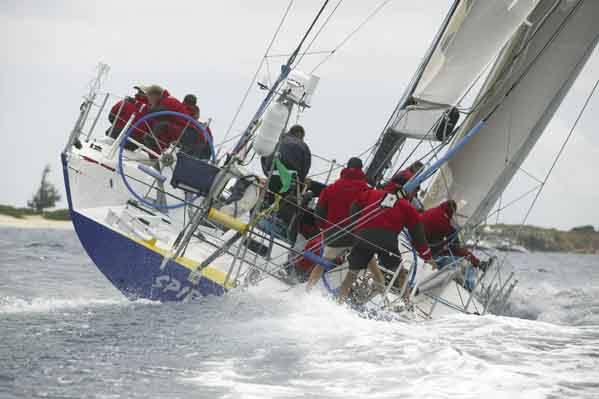
Above: Spirit will add spice to the BMW Round Ireland 2004 in Irish waters thanks to a Howth YC campaign. Photo Tim Wright
My last attempt to skipper a Round Ireland was in 1996 when, as a group of insane teenagers, we thought it would be a great idea to compile a Youth Challenge for the race. I’m happy to say we didn’t see it through, because I’m sure that if we had pursued that dream, none of us would have lived to tell the tale. I have learned since that offshore sailing is not quite as easy as it seems.
Last August, I got the call from Fred and Jim, who were in Plymouth having just finished the Fastnet Race. They urged me to put pen to paper for a significant Round Ireland entry. I began a proposal that day and now it’s finally beginning to come to fruition. The pleasant part of planning has been the support we have enjoyed. It has been really positive and uplifting for me and the team. It hasn’t all been easy but we are determined to see it through to the finish. Wicklow here we come!
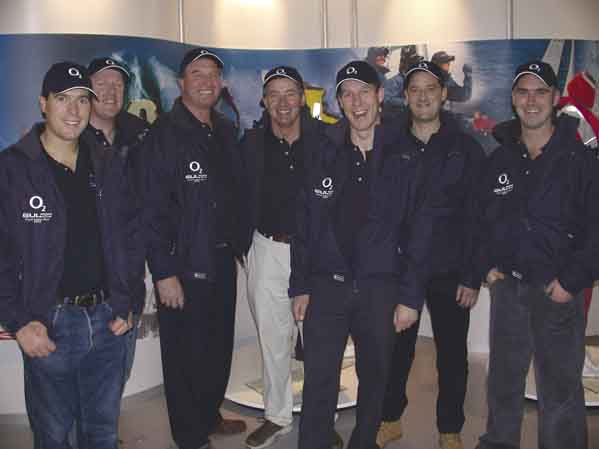
Above: Lift off – At the launch of Howth's Round Ireland campaign on the GUL stand at the London Boat Show are (left to right) Spirit's owner Hamish Oliphant, Irish Olympian Tom McWilliam, Veteran Jim Barden, Ireland's Round the World Skipper Joe English, O2's Round Ireland entry Skipper David Nixon, Fred Connolly and David Howard. Photo: Mark Jardine
I missed the last Round Ireland. While it was pleasant getting into a warm and comfortable bed on the night of the start, a little drunk, I couldn’t help but feel disappointed I wasn’t taking part. The Round Ireland is a magical race, I can’t quite say why, but it is magic. I guess with so many corners to turn and fabulous landmarks to pass, you can’t help but enjoy it.
However, my favourite part of the Round Ireland is the finish, something I think I share with all other sailors. I remember on board Cracklin’ in 98, we were off Rathlin and Jeep Cherokee had finished. How we envied them – pints and steaks all round in Wicklow Sailing Club. At that stage I realised we needed a faster boat.
Drawing up my current plan, I asked myself whether I could see it through. Happily I was reassured by a number of people around me, namely Jimmy Barden, Fred Connolly and Davie Howard. My brother was also very encouraging which was important as he has nothing to do with sailing – he just knew I’d do it.
My other question was whether I could actually skipper a substantial team racing a high performance racing machine. That can only be answered during the race, but my team believe I can and, with their support, anything is possible. I’m 26, and while my knowledge and experience may be somewhat limited, it’s the team that makes a crew and the attitude and approach of that crew that can bring the boat to victory.
The plan was simple from the start; procure the best resources available to give us the best possible chance to win the race and beat the record. Fundamentally that meant attaining sound and substantial sponsorship – not an easy task. It then meant finding the most suitable boat available and recruiting an appropriate pro-am crew. Pros were a must, but so too were amateurs since that’s a major feature of the campaign.
Ireland has a wealth of amateur sailors with excellent skills, knowledge and experience. The challenge, I believe, is to develop this to compete on the international scene. Having competed in the 2002 Commodores’ Cup, I feel there is a gulf between Ireland’s available resources and that required to compete at the highest level.
I had the opportunity to learn about the level of ability among professional ranks in 1998 when Roy Dickson kindly sent me off with Cracklin’ to race with a fully professional team on Barlo Plastics. We won, and it taught me a lot.
As an amateur, I feel the best way to improve my own ability is to race with professionals any chance I get. This pro-am mix is the philosophy of the modern day Commodores’ Cup, but it costs to live it. Commercial support in the form of sponsorship is essential to pay the bills.
So our Round Ireland project has longer term relevance. It provides us with training in two very important ways – sponsorship attainment and learning from professionals.
So how did we do it? Well, as with most things, there has been an element of luck. I called a colleague to help me with the proposal document and he liked the concept, so O2 got involved. Davie Howard has the GUL agency in his ProRig store so he put me in touch there and they also liked the plan. A couple of other sponsors have come on board since.
In the meantime we were looking for a boat, a search which proved quite difficult. The web and contacts are great but amazingly there are not that many good offshore boats available for charter. In the end we were very fortunate to get in touch with Pure Sailing, a Plymouth-based charter company with a VO 60, (Tyco from the last Volvo Ocean Race). Hamish Oliphant, the owner, was very interested by our proposal and signed up to the campaign.
 Left: The big one – A Volvo 60 will Race round Ireland under a Howth flag. Photo: Tim Wright
Left: The big one – A Volvo 60 will Race round Ireland under a Howth flag. Photo: Tim Wright
Finally the crew. We had a long list of our own guys that we wanted on the team, but it was essential to put together the right team. Jim Barden had the tough job of final selection. We got in touch with Tom McWilliam who agreed to sail with us and brought in Steve Hayles and Guy Salter, both of whom had raced on Tyco for the VOR. I also asked Joe English and Davie Harte onto the team. The owner brings three, taking the total number of pros to eight. We will compliment this with ten amateurs, most of whom would have sailed aboard Cracklin’ Rosie with Jim and I.
Time has flown in development of this campaign. Before we know it we’ll be lining up at the start in Wicklow. I can’t wait. The competition will be great, the race will be excellent. Even better, the finish in Wicklow awaits with pints and steaks all round. That’s what it’s all about!
Royal Cork stake early claim
Five of the nine entries received so far for the June 26 start of the BMW Round Ireland race are from Royal Cork in a fleet that Wicklow organisers ultimately expect to swell three-fold by the entry deadline of May 24.
The largest entry continues to be the Volvo 60 Spirit (David Nixon, Howth) but there are other big boats on the horizon according to organiser Denis Noonan.
A single entry has been received in the new two-handed class and it comes from the Isle of Man Yacht Club in the form of Andrew Bell's J105 sloop, Moontiger.
Dingle pair to take on Ireland
Co-skippers Aodhán Fitzgerald from Dingle and Frenchman Yannick Lemonnier will go head-to-head with fully crewed entries in the 704-mile Round Ireland race this year.
The pair aim to compete both in the two-handed class of the race as well as the overall fully-crewed IRC category.
Both co-skippers have impressive sailing credentials. Lemonnier competed in the Figaro single handed racing events for five years before he moved to Ireland in 2001. He has also competed in several two-handed transatlantic races as well as several Tour de France a Voile series.
Fitzgerald has been active in the Irish offshore racing scene for ten years, campaigning on the well-travelled GK 34 Joggernaut for the past eight years. Aodhan has competed in four Round Ireland races and two Fastnet races. Successes include an overall win in the 1999 Dún Laoghaire to Dingle race.
The team’s longer term ambitions include competing in next year’s Fastnet Race (two handed division) as a warm-up for the two handed transatlantic AG2R race in 2006. Further details can be found on the team’s website www.dinglesailing.com
COPYRIGHT AFLOAT 2004
Time out, round 13 (reprinted from the July 2004 issue of Afloat)
A showdown not witnessed in ten years is on the cards for the BMW Round Ireland Race as a surge of interest has seen a 60 per cent jump in entries from five countries for the 704-mile race

Above: With variable displacement, an IRC rating of 1.425, a canting keel and powerful sailplan French entry Solune’s performance is designed to match a Volvo upwind and an Open 60 offwind
Looking back over the past decade or more, it is clear that the only thing predictable about the Round Ireland race – and we are about to embark on the 13th – is it’s unpredictability. So will the 13th staging of Ireland’s classic offshore race be unlucky for some? Almost certainly, yes.
With a little over a week remaining before the start of the 704-mile BMW Round Ireland Race, entries have exceeded organisers' expectations and presently stand at 47 boats from five countries with further late entries tipping the 50 mark.
The non-stop race for monohull yachts gets underway at 14.00 hrs on Saturday June 26th 2004 from Wicklow Sailing Club and the first boats will be expected to finish just three days later following their southabout circumnavigation.
 Left: Denis Noonan all set for his third and final Round Ireland as race organiser
Left: Denis Noonan all set for his third and final Round Ireland as race organiser
Commenting on the entry, Race Director Denis Noonan said: "The response has been very encouraging as we had initially hoped that we might reach 40 boats. The introduction of a two-handed class is a factor and BMW’s sponsorship has helped raise the profile of the race considerably."
French giant aims to crush Irish Spirit
A war of words has broken out between the main contenders for this year’s Round Ireland title, as the fleet of 50 boats makes final preparations for the event.
Paris-based financier Jean Pierre Chomett has thrown down the gauntlet to main rival David Nixon by declaring that he has entered the record-breaking 60-footer Solune not only to win on the water but also to smash the race record.
Six years ago, Colm Barrington in Jeep Cherokee set a mark of three days, four hours and 23 minutes for the 704-mile course, (see 'Records...' below) but Chomett believes a sub-three-day time is possible.
In setting the Round Britain and Ireland record in May, Solune reached top speeds of 26 knots in short surf, but also managed to average 22 knots for long periods of the voyage. It’s all weather dependent, of course, but Chomett believes the new design – a cross between a Volvo and open 60 design – has a better upwind performance than the Volvo 60 in both light and strong winds, a key sailing angle in the Round Ireland event where up to half the race can be spent on that point of sailing.
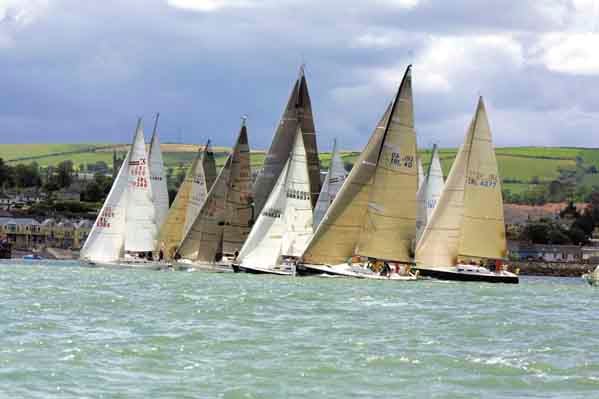
Above: The 2002 fleet departs Wicklow. Two years later the fleet has doubled in size and stature
However, 02 Team Spirit skipper David Nixon (26), who has chartered the Volvo 60 from the UK for the event, has dismissed the performance boasts of the French prototype. "As long as there’s breeze, we'll be okay," said the Howth skipper.
Built by the same team that created the Alinghi America's cup hulls, Solune broke the Round Britain and Ireland record by more than three days and 15 hours ahead of the previous record, a month ago. It was during that trip off the Irish west coast that Chomett made up his mind to return for a second record-breaking attempt.
There’s little doubt that the La Rochelle entry is up to the job. The broad-beamed boat comes complete with powerful gennaker, twin rudders and a canting keel. For the circumnavigation, Chomett will have Playstation's weather router and navigator Chris Tibbs of Cowes on board.
A third big boat for the fleet will be Dutch entry Second Love, a Standfast 64 that’s unlikely to prove a significant threat to the other pair as this boat is a Fast Cruiser design and lacks the performance advantages of stripped out interiors and lightweight equipment.
Nevertheless, this race is not about line honours or even a new course record – both are not part of the official event programme. The overall win is based on corrected handicap time that may yet give the Dutch boat an advantage.
Records
Records show how that between 1980s first race and Colm Barrington’s 1998 current record run that nearly 60 hours have been shaved off the circuit time. The race is on to be first round Ireland in under three days.
135:02:27 1980 Force ten-sion J.S. Morris, Pwhelli
99:45:25 1982 Moonduster Denis Doyle, RCYC
88:15:43 1984 Moonduster Denis Doyle, RCYC
84:56:06 1990 Rothmans Lawrie Smith, Royal Thames
76: 23:57 1998 Jeep Cherokee Colm Barrington, RIYC
Small may yet be beautiful
It’s all very well two big boats vying for the win on the water but as race followers know well the overall prize on corrected time typically only becomes clear once the small boats are back in Wicklow. Challenging the big boats for the race win in 2004 falls to a host of smart contenders of widely varying size; the recent light-airs RORC Cervantes Trophy Race in class zero featured three Round Ireland entries that illustrate this variety.
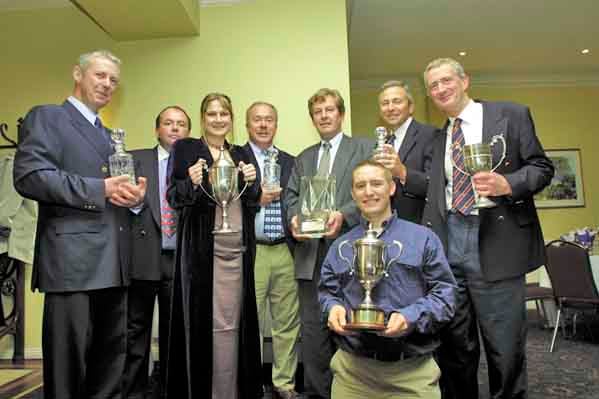
Royal Cork’s Eric Lisson (third from right) celebrates with the Cavatina crew after the 2002 race
Piet Vroon's 52-foot Tonnerre de Breskens, the Dutch winner of the 2001 Rolex Fastnet Race, took one hour off Anthony Richard's Minnie the Moocher, a Kerr 11.3 which in turn was 36 minutes ahead of Second Love after 110-miles of racing. For the Round Ireland, a large gap between the first, big boat finishers and the rest of the fleet finishing at Wicklow seems unlikely.
The list of handicap contenders must include another Jason Kerr design that has consistently proven problematic for bigger rivals and now has its sights set on this classic offshore course – Voodoo Chile, to be known as Calyx Voice & Data under Eamon Crosbie and his regular team from the National YC. As one of the smallest boats in the race, line honours is not an option for this 32-footer.
But Crosbie won't be the only smaller boat giving the big boys palpitations as they wait out the finishers at Wicklow Sailing Club. Eric Lisson and his Granada 38 Cavatina will be defending the 2002 title victory and, as the second-last finisher two years ago, nobody will be counting results on the basis of outside chances again.
Less predictable will be the new innovation for the 2004 race – a two-handed class that has attracted at least six entries. This will be a particularly tough challenge for some boats that range in size from 30 to 45 feet. One of the first entries came from Dingle pair Aodhan Fitzgerald and Yannick Lemonnier (see May Afloat), who have chartered Figaro Beneteau number 32, which has just arrived back from St Barths after completing the AG2R transatlantic. Entries in this class appear very competitive, with English interest centred on Thunder 2, a former winner of Cork Week class 0.

Left: Giant killer – Last time round in 2002, the Cavatina win came as such a shock that there was not even a picture of the boat available. The press had to make do with a shot of the comparatively petit and elderly Granada 38 footer on her moorings in the Curabinny river!
Overall, the revival in fortunes for the Round Ireland is to be welcomed and the increasing turnout is a testimony to the basic attraction of the race. The sheer unpredictability of the course, which fails to guarantee outright victory to the all-out racers, acts as a balance for the club crew and keeps the event within its original ethos.
Moreover, while just a handful of prizes are up for grabs, simply completing this challenging but achievable course places the event as a ‘must do’ for many crews and acts as an incentive to continue racing, often against the odds. For that reason alone, the Round Ireland has proven that reports of the death of offshore racing are very much exaggerated.
COPYRIGHT AFLOAT 2004
Here we go – Round 14 (reprinted from the June/July 2006 issue of Afloat)
The 100-foot Kiwi Pot-Hunter has arrived in search of a record. Afloat previews a 2006 Round Ireland fleet that has plenty of spice
At 4pm on July the 1st the BMW Round Ireland Yacht Race will set off from Wicklow Sailing Club. This year will be the 14th race to date and Wicklow Sailing Club officials are saying it will be one of the best and entries are still coming in well after the entry deadline so 2004’s 49-boat fleet could well be matched.
Race Organiser Denis Noonan had 41 entries as Afloat went to press (on June 16th) but is confident this figure should reach ‘in the region of the fifty mark’ as the big day draws near.
Either way, any deficiency in numbers is more than made up for in variety and this year Wicklow welcomes it's largest entry to date.
Owned by Stewart Thwaites, the record breaking yacht, 'Konica Minolta Zana' is a 30m super maxi yacht. She is due in Dublin in June with the intention of adding a Round Ireland Race record to an already formidable list of record times which she holds. The current record of 76hrs, 23 minutes and 57 seconds was set by Colm Barrington in Jeep Cherokee in 1998.
This will be the only competitive racing that the New Zealand yacht – sponsored by Lakeshore Funds – will participate in before heading down to the Mediterranean to compete in a number of events that include the Middle Sea race as well as the Maxi World Cup.
It was hoped that she could compete in Cork Week also, but this plan was scuppered by time constraints.
Konica Minolta Zana currently holds race records for the HSBC Coastal Classic Race, the Auckland to Suva race and the Auckland to Noumea race, as well as a string of top finishing positions in the Sydney Hobart.
Aboard Konica Minolta Zana will be a plethora of top class international sailors including Gavin Brady (watch captain), multiple world champion, Americas Cup and Volvo sailor, Steve Hayles, (navigator) ex-Oracle and with four Whitbread/Volvo races under his belt, Rodney Keenan (watch captain) ex-Volvo, etc., Kip Stone, first in Open 50s single handed yachts.
Among her crew will be Martin Hannon, originally from Newtownards who now lives in New Zealand. Adding a bit of local knowledge to the team will be GP champion Ruan O'Tiarnaigh.
However, size does not always matter in a race of this magnitude, with past winners including Calyx Voice & Data, Imp, and Cavatina all weighting-in at 40 foot and under.
One of the smallest boats in the fleet, Eamon Crosbie’s 32 footer Voodoo Chile (last time known as Calyx Voice & Data) is back racing as Teng Tools to retain his title.
Ireland West Tourism and Ireland West Airport Knock have joined in sponsoring an entry.
Aodhán Fitzgerald, winner of the 2004 Round Ireland two-handed class with Yannick Lemonnier, heads the twelve strong Team Ireland West, drawn from the membership of Galway Bay Sailing Club. They will be sailing a race-optimised Beneteau 40.7 yacht, chartered specially for the event, under the name ‘Ireland's West’. Well-known Galway sailor Barry Heskin will be watch leader, while Galway man Noel Butler, a former Laser 2 World Champion and helm of the winning boat in Class 1 at the UK's Cowes week last year, will be principal helmsman.
Another west coast entry are upping the ante with the charter of a Volvo 60. The group, known as the Spirit of Kilrush team, will have Simon McGibney among its crew. They have completed a number of training sessions on the boat in Cowes.
J.P. Chomette, on board Solune who holds the Round Ireland monohull record, is back and this time means business after some reworking of his canting keel 60-footer. Navigator Chris Tibbs is on board the French entry again.
This year will again be a very special one in our Double Handed Fleet, which already boasts Nunatak, skippered by Mike Jacques, and Moontiger driven by Alan Bell.
Yannick Lemonnier and Mark Greely of Dingle, Sailing Club, are fine-tuning their Beneteau Figaro 2 which they’re chartering with the support of their sponsor Southbound Group in the two-handed category.
Yannick and Mark have been sailing together for a number of years and came second in the Dun Laoghaire to Dingle race on board Southbound in 2005. The boat’s racing name for the Round Ireland is Southbound.ie and you’ll be able to follow the their progress and race position due to the addition of a tracking system on board the competing boats this year.
However, the BMW Round Ireland Yacht Race is not only about the intense offshore race, there is also an extensive social event for all the crew and spectators. The party kicks off in Wicklow on Wednesday the 28th and carries the whole way to the start and after.

1 The big one cometh! At over 100 foot surely Barrington’s 1998 record will fall? All eyes will be on the Konica Minolta Kiwi entry.
2 Do Dingle.com was the two handed winner in 2004, two years later skipper Aodhan Fitzgerald is heading up Team Ireland West.
3 Limerick’s Andrew Carey during training on the Western Yacht Club’s Volvo 60 entry Spirit of Kilrush
4 Sean Lemass and the National YC crew on Gallileo are keen offshore campaigners
5 A winner offshore and a winner round the cans: Chieftain’s skipper Ger O’Rourke has his eyes on handicap honours in the canting keel fifty footer.
6 Jean Phillipe Chomette already has a Round Ireland speed record under his belt. Now the Paris financier is eyeing a race record too in the Nacira 60 City Jet
7 Sarnia, a veteran S&S 36 from the National YC.
8 and 11 Yannick Lemonnier and Mark Greely of Dingle Sailing Club are entered in the double handed category. The boat’s racing name for the Round Ireland is Southbound.ie
9/13 Waiting for the start at Wicklow
10 Minnie the Moocher, a race leader til Mew island in ‘04, the Kerr 11 metre is back
Afloat opinion
Wicklow Sailing Club rolls out its 14th Round Ireland race but its appeal, though deserving of far greater international note, remains rooted in a small domestic fleet.
The club have received 41 entries as Afloat goes to press and it is likely to swell with late entries to over 45 or more before the July 1 start. Over half of the fleet is from Dublin and Cork. The balance of the domestic fleet, totalling 29, is made up from entries from the West coast, Waterford, UK and French entries, and one very large Kiwi boat make up an overseas entry of 12.
The failure to capitalise on the success of the 2004 event with a bigger fleet this time round will be seen, by some, as a disappointing outcome for a number of reasons but primarily because if it is – as so often it is claimed to be – one of the world's classic offshore races, then its fleet could, as with Australia’s Sydney-Hobart or Britain’s Fastnet fixture, number in excess of 100 boats. There are 50 Irish yacht clubs around the coast but only 11 have sent entries.
The biggest club presence is from the Royal St. George, sending five boats. The country’s largest club, Howth, has a single entry. Only three of the four Dun Laoghaire clubs are sending boats. The home of the country’s biggest sailing centre, with the Wicklow start line on its doorstep, can only muster 12 in total.
Cork's race veteran Eric Lisson was clear about club support when he lifted his overall prize in 2002. He pleaded with offshore sailors at the time to go out and canvass for it's future support.
Lisson, who took second in the 2005 Fastnet Race, knows the potential of the Round Ireland is not just as another ‘passage race’ as RORC describe it but as a symbol of Irish sailing. He suggested that if each of the 30 skippers or so could attract one more clubmate then quite simply they would double the size of the fleet. Two years later, 49 entries and a big breeze meant 2004 went down as a highlight of the race’s 28–year–history.
But now four years on, the exact reason for the lack of growth can most precisely be attributed to a clash of dates with the Commodore's Cup. Ireland is fielding three teams and with a strong entry for the Cowes event (see page 24), this has had a direct effect on Round Ireland numbers and crew availability. But even this is too convenient an excuse for a race whose true strength lies abroad.
What really is at stake for Irish sailing is much more than running a local yacht race. The Round Ireland is the perfect offshore race course and it needs to be sold as such.
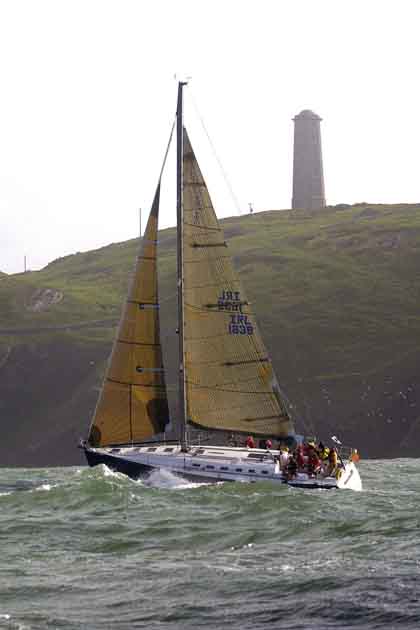
Pictured left: Adrian Lee’s Beneteau Irisha passes below Wicklow head at the start of the 2004 race
The entire sailing community headed by the Irish Sailing Association (ISA) or another body needs to get behind Wicklow and assist it in promoting this 704-mile offshore race as an icon of Ireland's summer sport.
Nowhere was this point more clearly made than in early June when the world's top offshore sailors called in unexpectedly to our South and West coasts.
They came principally in search of wind in leg eight of the Volvo Round the World race. They found little wind, unusually, but before they left they wrote prose worthy of a Failte Ireland copywriter.
In his log Navigator Simon Fisher from ABN AMRO TWO wrote: “Our day started sailing in and out of the mist rolling down off the hills and, as the sun rose and the mist burnt off, it gave way to spectacular views of rolling green hills and a weather-beaten rocky coastline. With castles and towers stationed on each headland, it gives you the feeling of sailing through a scene out of Lord of the Rings.”
COPYRIGHT AFLOAT 2004
See Navigating Round Ireland Tips
More on the Round Ireland Yacht Race:
Round Ireland Yacht Race 2010 Review
Round Ireland Yacht Race, Ireland's top offshore fixture
A Round up of 80 stories on the 2010 Round Ireland Yacht Race































